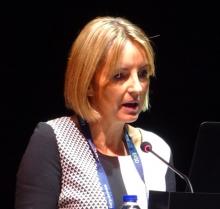LISBON – , according to the investigators of a prospective, multicenter, randomized, controlled study who found that it improved a number of neonatal outcomes.
In the open-label Continuous Glucose Monitoring in Pregnant Women with Type 1 Diabetes(CONCEPTT) study, infants born to mothers who had used continuous glucose monitoring (CGM) versus those who had not had a 49% lower chance of being large for gestational age (53% vs. 69%, odds ratio [OR] 0.51, P = .0210) and were 52% less likely to need neonatal intensive care lasting for longer than 24 hours (27% vs. 43%, OR 0.48, P = .0157).
Neonates born to mothers who used CGM during their pregnancy were also less likely to experience hypoglycemia (15% vs. 28%, OR 0.45, P = .0250) and were able to leave the hospital with their mother 1 day earlier (P = .0091) than those born to mothers who did not use CGM.However, these were secondary outcomes of the study, which first looked at how CGM affected the glycemic profile of the mother.“To the best of our knowledge, this is the first trial to demonstrate a benefit of CGM on health outcomes beyond glucose control,” Helen Murphy, MD, one of the CONCEPTT trial’s two principal investigators, said at the annual meeting of the European Association for the Study of Diabetes.
Dr. Murphy, who is an honorary consultant physician at Cambridge (England) University Hospitals NHS Foundation Trust and at Norfolk & Norwich NHS Foundation Trust, observed that the improved neonatal outcomes were likely a result of reduced exposure to maternal hyperglycemia.“We would suggest, on the back of these data, that CGM should be offered to all pregnant women with type 1 diabetes using intensive insulin therapy during the first trimester,” Dr. Murphy said, adding that results of the study were simultaneously published online in the Lancet (2017 Sept. 15. doi. 10.1016/S0140-6736(17)32400-5).
“The CONCEPTT study will change the future for pregnant women with diabetes,” commented Elisabeth Mathiesen, MD, who was the EASD’s invited discussant for the study, and who congratulated the investigators for “a well performed study” and being “brave,” as “performing a RCT [randomized controlled trial] in pregnancy is not easy”.
Satish Garg, MD, and Sarit Polsky, MD, of the Barbara Davis Center for Diabetes at the University of Colorado, Denver, agreed in an editorial (Lancet 2017; Sept. 12. doi: 10.1016/S0140-6736(17)32449-2) accompanying the published article that the study findings were clinically important.
“We believe that the CONCEPTT results support CGM use during pregnancy for all women with type 1 diabetes,” they wrote, adding that the mother’s “time in [glycated hemoglobin, HbA1C] range might become an important measure in pregnancies with type 1 diabetes.”
Dr. Garg and Dr. Polsky also suggested that endocrine and obstetric medical societies take note and perhaps revise accordingly their guidelines on the use of CGM during pregnancy in diabetic women.
CONCEPTT involved 325 women with type 1 diabetes; 215 were pregnant at the time of enrollment, and 110 were planning on becoming pregnant in the near future.
Co-principal investigator Denice Feig, MD, of Sinai Health System in Toronto, explained that women were eligible for inclusion in the trial if they had type 1 diabetes for at least 1 year, were aged between 18 and 40 years, and had been using daily insulin delivered by either an insulin pump or multiple daily injections (MDI). At enrollment, the participants’ insulin regimen had to been stable for at least 4 weeks before randomization to CGM with capillary glucose monitoring or capillary glucose monitoring alone and their glycemic control had to be suboptimal.
Two groups of women were studied: a “pre-pregnancy group” of women who were planning on pregnancy and wanted to optimize their glycemic control before conception, and a “pregnancy group” of women in their first trimester (less than 14 weeks’ gestation) who were due to have a live, singleton birth as confirmed by ultrasound.
The primary outcome of the trial was the change in HbA1C from baseline to 34 weeks, with pre-specified secondary outcomes of various CGM measures, neoneonatal outcomes, and patient-reported outcomes.
Pregnant women using CGM had lower HbA1C levels during the trial than women who did not have CGM monitoring, although the difference was small (–0.19%, P = .0207).
The use of CGM was associated with more time spent in target HbA1C range (68% of women using CMG vs. 61% of those not using CGM, P = .0034), with less time being hyperglycemic (27% vs. 37%, P = .0279) and comparable rates of hypoglycemia (17 vs. 21 episodes) and time spent being hypoglycemic (2% vs. 4%, P = .10).“The CGM effects were very comparable among insulin pump and MDI users and across 31 international sites,” Dr. Murphy summarized, although she noted that there was no consistent benefit of using CGM seen in women who were planning a pregnancy. Dr. Feig noted that the strengths of the study were the large sample size and that CGM was used continuously from the first trimester until delivery. Women using both pumps and MDI were included at multiple centers and countries, and HbA1C was centrally assessed, with detailed CGM measures used in an exclusively type 1 diabetes population.“Of note, one needed to treat only six women with CGM to prevent one episode of large for gestational age,” Dr. Feig reported. “One needed to treat only eight women to prevent one neonatal hypoglycemia, and six women to prevent one NICU [neonatal intensive care unit] admission over 24 hours.”
There were some limitations, of course, including: around 20% of women had missing data on their HbA1C level; women using CGM also made more unscheduled visits to their health care providers although there are no data on the frequency of self-monitoring of blood glucose or frequency of insulin bolus dosing; and the study was open label.
In her independent précis of the trial, Dr. Mathiesen, professor of endocrinology and chief physician managing pregnant women with diabetes at the Rigshospitalet University Hospital in Copenhagen, noted that there were some other downsides to using CGM in the study.
Dr. Mathiesen said that “80% of women had self-reported problems with using the sensor, half of them experienced skin problems, and approximately 30% of women used the sensor less than 75% of the time, so not everybody was very keen on the sensor” and “using sensors deserves extra effort and time from the caregivers, especially from the nurses.” Dr. Mathiesen queried the cost of using CGM in all women with type 1 diabetes during their pregnancy; the cost of CGM use in 20 pregnant women, for example, was the equivalent of employing one nurse in Denmark, she suggested. That said, Dr. Mathiesen acknowledged that there was now evidence-based data to consider using CGM in selected pregnant women with type 1 diabetes.The CONCEPTT study was funded by the Juvenile Diabetes Research Foundation, the Canadian Clinical Trial Network, the National Institute for Health Research, the Center for Mother, Infant, and Child Research, and the Jaeb Center for Health Research. Medtronic also supported the study by providing the CGM sensors and systems at a reduced cost. Dr. Feig declared she had no competing interests. Dr. Murphy disclosed sitting on an advisory board for Medtronic and receiving personal fees from Novo Nordisk and Roche, unrelated to the current study. Dr. Mathiesen was the invited EASD independent commentator for the trial and did not give any disclosures. Dr. Garg has received advisory board consulting fees and research grants from Medtronic and several other pharmaceutical companies specializing in diabetes care. Dr. Polsky has received research funding from DexCom for diabetes device use in patients with diabetes paid directly to the University of Denver.



